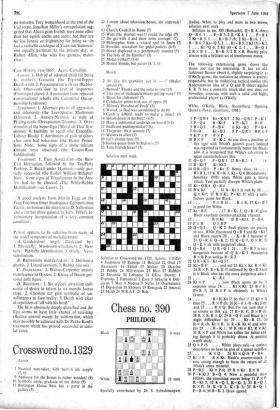Chess no. 390
PHILIDOR
Black White 6 men Specially contributed by Dr S. Subrahmanyam (India). White to play and mate in two moves; solution next week.
Solution to no. 389 (Bottacchi). Q - R 4, threat Q-B 6. 1 ...P-B 3; 2 R-K 4. 1 ...P-B 4; 2 Kt-B 5. 1 R -B 3 ch; 2 Kt-Kt 6. 1 ... R - B 4; 2 Kt.- Q 5. 1 ... Kt - B 5; 2 Kt (3)-K 2.
1 . . . Kt - Q 6; 2 Kt (4)- K 2. 1 . . . B - Q 4; 2 R X B. 1 . . . B -K 5; 2 R X B. Worthy prize- winner with a brilliant set of interference mates.
The following entertaining game shows that draws too can be interesting. It has an old- fashioned flavour about it, slightly surprising in an O'Kelly game; the variation he chooses is entirely respectable, but its underlying tactical motive (the Anderssennian idea of a Q and B threat against K R 7) has a romantic touch that one does not nowadays associate with such a solid and highly professional player as O'Kelly.
White, O'Kelly. Black, Rautenberg. Opening, Queen's Pawn. (Germany, 1968.) 1 P-QB4 Kt-KB3 2 Kt-QB3 P-K 3 3 P-Q 4 B-Kt5 4 P-K3 0-0 5 B-Q3 P-B 4 6 Kt-B3 P-Q4 7 0-0 Kt-B3 8 P-QR 3 BP xP 9 KPxP PxP 10 B x P B -K 2. At one time a position of this type with White's queen's pawn isolated was regarded as fundamentally better for Black; now it is recognised that White's advantage in space counterbalances this.
11 Q-Q3 P-QR 3 12 B-R 2 F . t 4
13 B-Kt 5 B -Kt 2 14 Q R - Q 1 P - Kt 5! Better than 14 . . . R- B 1; 15 K R -K 1, Kt - Q 4 (Bondarevsky- Sokolsky 1950) when White gets a strong attack. Text partially disrupts White's plans.
15 Kt-QR 4 Q-R 4 16 B x Kt ... 16 B - Kt 1 is met by 16 ...
Q x Kt!; 17 B x Kt, P - Kt 3! with a satis- factory game for Black.
16 . . . P x B 16 ... B x B; 17 Kt-B 5 is good for White.
17 Kt - B 5! . . . 17 B - Kt 1, Q - R 4! gives Black excellent counter-attacking chances.
17 . . . B X Kt 18 B - Kt 1 P - B 4 19 P X B Qx BP 20 Q - Q 2 Q-K 2. Both players are playing to win. White threatened Q - R 5 and Kt-Kt 5 and Black rejects 20 . . . K - R 1 because of
21 Q-R 6, Q-K 2; 22 R-Q 7, Q x R; 23
Q - B 6 ch with perpetual check.
21 Q-R 6 Q R-Q 1. 21 ... P-B 3 is very dangerous because of Q R - K I threatening B x BPas well as B-R 2.
22 QR-K 1 Kt-Q 5!
23 Kt - R 4! . .. and not 23 Kt X Kt, R X Kt; 24 B x P, R -K R 5! followed by Q-B 3 and it is Black who has the more dangerous attack.
23 . . . K - R 1 •
24 Kt x P . .. now Black seems to be in extremis since 24 . . . Kt x Kt; 25 B X Kt, P - B 3; 26 R x P is obviously in White's favour.
24 . . . R -K Kt 1! So that if 25 Kt X Q then 25 ...R x Pch; 26 K-R 1, R-Kt 3 ch; and 27 . . . R x Q. But I'm not sure that is so simple as this, e.g. 27 B - K 4!, B x B ch; 28 R x B, R X Q; 29 R - Q 1! and Black is in slight difficulties: (a) 29 . . . Kt - B 3?; 30
R x R ch, Kt x R; 31 R - K Kt 4! and wins; (b) 29 . . . R-K 1; 30 R (4) x Kt, R X Kt; 31 R x P and White has rather the better end- ing though it is probably drawn. A position worth study.
25 Q x P ch . . , White plays safe-a curious description to have to give of a queen sacrifice.
25 . . . K X Q 26 Kt x Qch P-B 4
"4'7 Kt X R R x Kt. Black's counter-attack is - now strong enough to force the return of all White's extra material.
28 P -B 3 Kt x P ch 29 R x Kt B x R 30 P- K Kt 3 B -Q 4. Now a peaceful draw follows, the remaining moves being 31 P X P. R-Kt 5; 32 R-Q 1, K-Kt 3; 33 R-Q 2 R x P; .34 K-B 2, K-B 3; 35 B-Q 3. P - R 4; 36 B - K 2. Draw agreed.






































 Previous page
Previous page